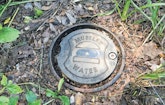
A member of the Clayton County Water Authority collects water samples for monitoring. The utility has moved to an automated flushing system to improve water quality and boost efficiency.
Giving residents access to safe, clean drinking water can be one of the most capital-intensive and operationally significant services that a water utility provides.
With a distribution system that spreads over 1,500 miles and produces up to 42 million gallons of potable water per day, the Clayton County Water Authority — located just south of Atlanta — knows the value of automated flushing when it comes to maintaining water quality, minimizing water loss and keeping work crews productive rather than the expense of rolling another truck to manually flush.
A couple of years ago, Clayton County was experiencing low chlorine residuals in certain areas, even though they were spending many hours flushing water mains. This led to the purchase and installation of eight Hydro-Guard HG-2 automated flushing units that reduced 15 man-hours of weekly flushing down to 1 hour and 20 minutes and raised chlorine residuals to acceptable levels. Additionally, the installation reduced water use from 3,384,000 gallons per month with manual flushing to 933,300 gallons per month with automated flushing. That’s a 72% monthly saving on nonrevenue water just from automating flushing practices.
The water authority does weekly chlorine residual testing, with increased frequency during the summer months when warmer temperatures allow for higher bacterial growth. Initially, these areas were being automatically flushed once a week, but then the water authority began to look at each zone on a case-by-case basis. This investigation resulted in fine-tuning the frequency and duration of flush, which is easy to do with Hydro-Guard automatic flushing units because it’s a simple setting adjustment.
“Typically, we find that flushing more frequently and for shorter periods gets us the best water-quality results and uses the least amount of water,” says Adam Horton, distribution and resource coordinator for Clayton County Water Authority. Frequent flushing for Clayton County can be every other day for one hour.
The initial eight HG-2 units were calculated to have paid for themselves in five months. The results were impressive enough that the utility now keeps its own inventory of Hydro-Guard units at sampling sites. By keeping units in stock, they can quickly deal with water-quality changes in their water distribution network that can give rise to dead-end lines or decreased chlorine residuals.
“With inventory on hand, we can often preempt complaints by adding flushing units where usage is low and solve low chlorine residuals on the first fix,” Horton says.
Clayton County now has 25 Hydro-Guard HG-2 automated flushing units safeguarding the county’s water quality 24 hours per day. Flushing is scheduled when demand is low, which results in less disruption to water customers and provides consistent, safe, clean drinking water. Most of the flushing units have been connected with meters on the downstream side, so the utility is able to get very accurate readings on water loss from flushing.
“It also gives us a safety net, as we can set alarms for unpredicted water loss,” Horton says. “For example, if a battery needs to be replaced, it could result in the flushing system not shutting off.
“The Hydro-Guard units have been a blessing to Clayton County in more ways than one — we have improved water quality, with less water loss and require fewer man-hours to do the job.”







